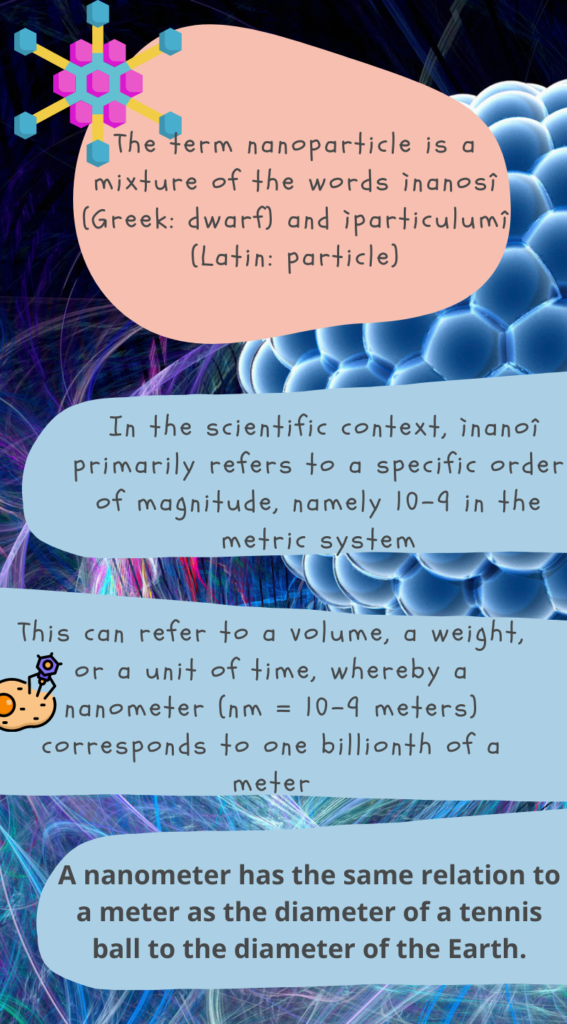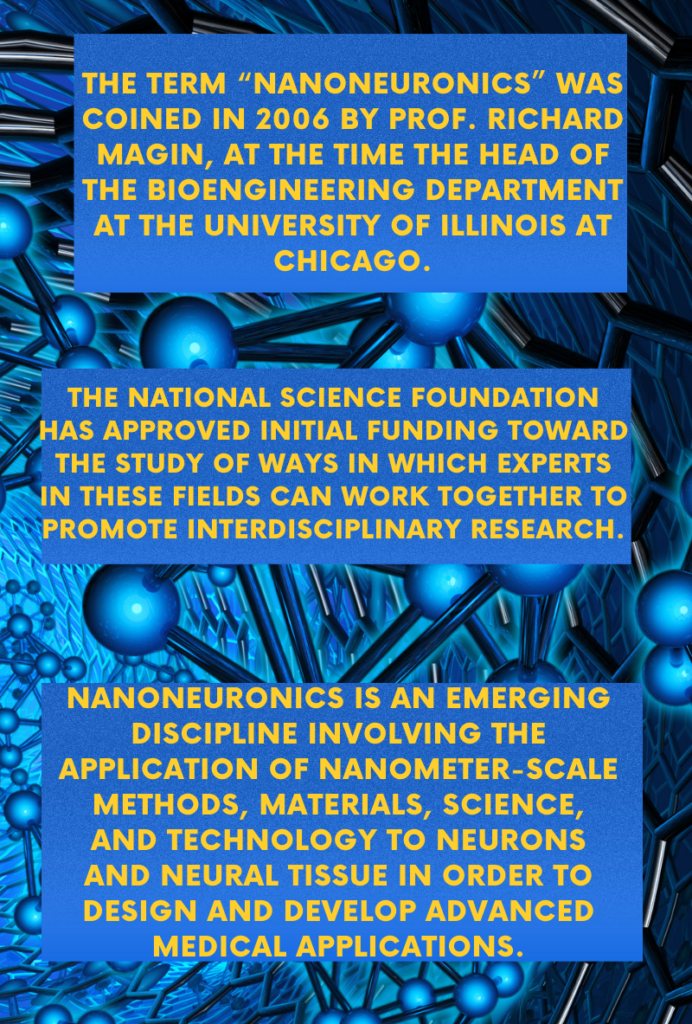Nanoparticles types have touched almost every sphere of the global market with involvement in various industries ranging from cosmetics and healthcare to preservation of the environment and purification of air.
Nanoparticles are a class of materials that comprise small particulate substances. The European Commission (2011) defined nanoparticles as, “A natural, incidental or manufactured material containing particles, in an unbound state or as an aggregate or as an agglomerate and where, for 50% or more of the particles in the number size distribution, one or more external dimensions is in the size range 1 nm–100 nm”.
The International Organization for Standardization, in 2008, defined nanoparticle as nano-objects that has all its three Cartesian dimensions less than 100 nanometers. The size range of these particles varies from 1-100 nanometers (1 nanometer = 10-9 meters). Because of their submicroscopic nature, the particles are undetectable by the human eye.

Nanoparticles had been in exposure to humans for a long time, but it was Richard Adolf Zsignmondy, the Nobel Prize winner in Chemistry in the year 1925, who introduced the concept of ‘nanometer’ and observed and measured the size of nanoparticles. Zsignmondy made it possible to observe nanoparticles through the illumination of the preparation which was being studied in the perpendicular direction to the viewing angle.
It is found that a nanoparticle consists of only a few hundred atoms. Also, the configuration of atoms is very much like that of a nanoparticle. Like in an atom, a nanoparticle also has a core element and surrounding coating ligands, which provide stability to the core material, promote interactions with targeted objects and make them soluble in some solvents. The surfaces of nanoparticles types can be made positively or negatively charged by coating the ligands.
Nanoparticles possess three prominent physical properties. These include:
- Nanoparticles have high mobility in a free state. This can be understood from the fact that in absence of any additional influence, silica, with a diameter of 10 nm, gets sedimented under gravity at the rate of 0.01 mm per day in the water.
- Nanoparticles have a large specific surface area. For example, silica nanoparticle with 10 nm diameter has more surface area as compared to a dozen of double-sized tennis courts.
- Nanoparticles exhibit quantum effect and therefore they have a large composition range, according to the use or the product.
Over the last few years, there has been an undeviating growing interest in using nanoparticles types in different biomedical applications such as targeted drug delivery, hyperthermia, photoablation therapy, bioimaging, and biosensors. Iron oxide nanoparticles have dominated applications, such as drug delivery, hyperthermia, bioimaging, cell labeling, and gene delivery, because of their superior properties such as chemical stability, non-toxicity, biocompatibility, high saturation magnetization, and high magnetic susceptibility.

Nanoparticles types can be categorized into different, depending upon their shape, size, and material properties. The two main categories of nanoparticles include Inorganic-based nanoparticles and Organic-based nanoparticles.
Inorganic nanoparticles are biocompatible, hydrophilic, non-toxic, and highly stable elements. These elements can be produced easily and cheaply. This property makes them fit for integration into applications. Shape-controlled inorganic nanoparticles types are among the most promising candidates as building blocks in nanoscale materials and devices, both because their physical properties are modified considerably compared to those of spherical nanoparticles types and because their intrinsic geometry opens many new opportunities for their assembly into organized superstructures. An overview of the inorganic nanoparticles types can be got based on their synthesis, applications, and perspective.
Inorganic nanoparticles with tailored optical, electronic, chemical, colloidal, and magnetic properties can be synthesized by different methods that allow the control of the nanoparticle size and shape. Current methods for nanoparticle synthesis and surface modification match the requirements for biomedical applications. However, there is still room for improvements in terms of narrower size distributions, improved crystallinity, and homogeneity in chemical composition, which will strongly affect the nanoparticle properties. Also, the challenge remains of developing cleaner, less contaminating synthetic routes preserving good colloidal properties.

Inorganic nanoparticles types such as quantum dots (QDs), gold nanoparticles (AuNPs), silver nanoparticles (AgNPs), carbon nanotubes (CNTs), and mesoporous silica nanoparticles (MSNs) play a significant role in many fields, such as sensing, bioimaging, and drug loading and are receiving increasingly more attention from researchers and undergoing extensive research in pharmacy. Inorganic nanoparticles types are difficult to degrade in vivo and cause damage to normal human cells, which has limited their usage in pharmacology, but their broad application prospects in the pharmaceutical field should still be recognized.
During the last decade, various functional nanostructured materials with interesting optical, magnetic, mechanical, and chemical properties have been extensively applied to biomedical areas including imaging, diagnosis, and therapy. In therapeutics, most research has focused on the application of nanoparticles as potential delivery vehicles for drugs and genes, because nanoparticles in the size range of 2-100 nm can interact with biological systems at the molecular level and allow targeted delivery and passage through biological barriers. Recent investigations have even revealed that several kinds of nanomaterials are intrinsically therapeutic. Not only can they passively interact with cells, but they can also actively mediate molecular processes to regulate cell functions. This can be seen in the treatment of cancer via anti-angiogenic mechanisms as well as the treatment of neurodegenerative diseases by effectively controlling oxidative stress. As active materials to be used in both diagnosis and therapy, inorganic nanoparticles are of great interest in nanomedicine.
Inorganic nanoparticles have been applied in several therapy strategies, including active drug delivery, hyperthermia, and magnetothermal against cancer, and their use offer advantages in medical applications due to their physicochemical characteristics, such as localized surface plasmon resonance (LSPR) effect—present in gold and silver nanoparticles, for example—and the magnetic and photoluminescence properties of magnetic nanoparticles and quantum dots, respectively. The application of inorganic nanoparticles in molecular imaging and drug delivery has benefited from their reduced size, which allows the inorganic nanoparticles to overcome cell barriers that conventional drugs cannot do, such as the blood-brain barrier.
In addition to the physical and chemical properties of the inorganic nanoparticles, their surface modifications using biomolecules provide specificity to the nanocarrier systems to increase absorption and biodistribution.
Inorganic nanomaterials of different chemical compositions and morphologies have been applied in cosmetic products due to their size- and shape-dependent properties which can improve the performance of the products
Organic nanoparticles are present in nature and, they form a constituent of many industrial products. Organic nanoparticles are expected to have potentials because the variability in the synthesis and tailoring of organic compounds is infinite.
Thus, small molecular organic nanostructures have attracted intense attention as they can offer tunable electronic and optical properties via molecular design. Most of the organic nanoparticles involve several organic or polymeric molecules, which sometimes is a limitation to control size below certain values. Also, organic nanoparticles like micelles or vesicles have a dynamic character and can change the size and shape with time through self-assembly or fusion.
Organic nanoparticles can load molecules either by conjugation on the surface or in the core or by physical encapsulation, which makes them appealing systems for the delivery of molecules and more specifically for drug delivery and biomedical applications.
These are characterized for dimension, morphology, surface properties, internal structures, and biological properties to understand structure-function correlations and to explore their applications. These potential applications include modifying physical properties, improving sensory attributes and food quality, protecting labile compounds, and delivering encapsulated bioactive compounds for improved bioactivity and bioavailability.

Nanoparticles isolated from plants have been demonstrated to have unique properties for biomedical and industrial applications. The method of extraction consists of multiple purification steps, including pre-filtration, dialysis, and size exclusion chromatography.
Organic nanoparticles act as antibacterial agents. Many synthetic methods have been used to prepare organic nanoparticles. Nanoparticles synthesized were confirmed by various analyses. In the future, more research should be focused on the preparation of organic nanoparticles. These particles can be applied in future studies to assess their applicability in different fields. Organic nanoparticles suitable for application in food are lipid-, protein- or polysaccharide-based particles.
In the context of food systems, organic nanoparticles are fabricated from proteins, carbohydrates, lipids, and other organic compounds to a characteristic dimension, such as a radius smaller than 100 nm
Organic nanoparticles with intriguing features have attracted widespread attention for various biomedical applications, such as disease diagnosis, drug delivery, bioimaging, and cancer therapy. Therefore, considerable efforts have been made to develop different strategies for constructing organic nanoparticles with distinct morphologies and properties
Organic nanoparticles can be fabricated with the “top-down” techniques and “bottom-up” techniques. In the “top-down” techniques, methods like mechanical milling and other more complex ones involving microfluidics and lithography are employed.
In the “bottom-up” techniques, nanoparticles are fabricated from atoms or molecules via synthetic chemistry and self-organization to generate a wide range of systems such as micelles, vesicles, and liposomes, polymersomes, polymer conjugates, dendrimers, capsules, and polymeric nanoparticles. The pharmaceuticals industry has led the research into organic nanoparticles over recent years.
The search for nanomedicines has driven the development of new materials and the refining of well-established techniques. The ‘bottom-up’ synthesis of nanoparticles capable of encapsulating or carrying active molecules has seen the production of dendrimer technologies, protein conjugates, DNA delivery vehicles, liposomes, and shell-cross-linked block copolymer micelles, to name just a few. ‘Top down’ techniques have focused mainly on attrition approaches such as wet nano-milling to grind large particles and achieve particle distributions with sub-micron average particle diameters.
Some other categories of nanoparticles include:
- Carbon-based nanoparticles: Important features of these particles include electrical conductivity, high strength, electron affinity, structure, and versatility.
- Metal: These particles are made of metals precursors. These particles have unique optoelectrical properties because of Localized Surface Plasmon Resonance (LSPR).
- Ceramic: These are a type of nonmetallic solids and receive great attention from researchers. This is because of its application in catalysis, photodegradation of dyes, photocatalysis, and imaging application.
- Semiconductor: These are important materials in photo-optics, photocatalysis, and electronic devices.
- Polymers: These nanoparticles are used for sensor technology, catalysis, surface coating, and nanomedicine.
- lipids: These nanoparticles have lipid moieties and are needed for different biomedical applications like drug carriers. These are highly promising systems to deliver nucleic acids in gene therapy because of their optimal properties inclusive of high biocompatibility and close similarities to the lipidic membranes.
Nanotechnology is the manipulation of nanoparticles with the objective of satisfying different industrial purposes. It improves a variety of businesses, including the pharmaceutical industry, the food industry, environmental protection, and a variety of others. In the current scenario, nanotechnology is an upcoming sector responsible for advancement in research and a range of industrial applications. Continuous developments and progress in this area have the potential to offer revolutionary hopes in multiple sectors. Although, these rewards come along with certain risks and negative impacts. Recently, the scientific community has started paying attention to these social and ethical concerns associated with nanotechnology. Nanoethics is an evolving discipline focusing on the scientific examination of these ethical, legal, and social issues.
Nanoneuronics, a related concept to nanoparticles has been popularized in recent times. It is the new engineering discipline that has the objective of harnessing the collective ability and knowledge of nanotechnology, neuroscience, neural engineering, electrical engineering, and ethics. It is undertaken to design and develop advanced medical interventions with the nervous system. It involves the application of nanometer-scale methods, materials, technology, and science to neurons and neural tissue for designing and developing advanced medical applications. There are a large number of neurological conditions that call for invasive approaches for ensuring effective therapy even when non-invasive approaches to the nervous system have resulted in an effective diagnosis and therapy treatment.

Nanoneuronics may be seen as an important medium to understand diseases like Down syndrome, addiction, brain tumors, epilepsy, etc. It can provide a great understanding of various neurological factors and aid in developing medications and planning out other strategies for treating and preventing health issues that seem to be uncurable with other forms of treatment.
